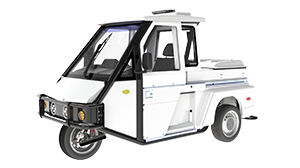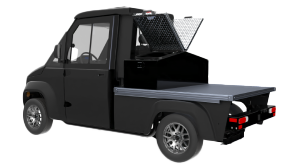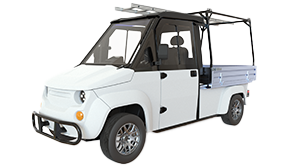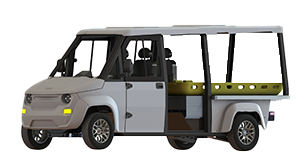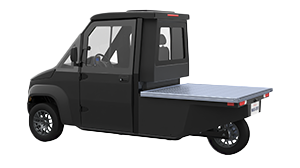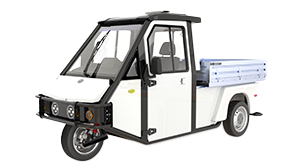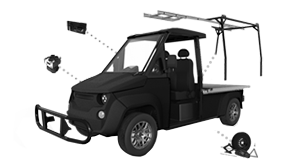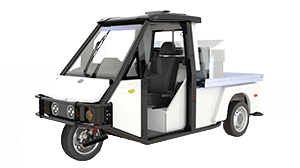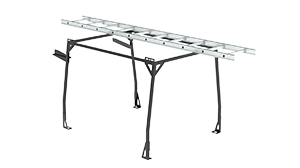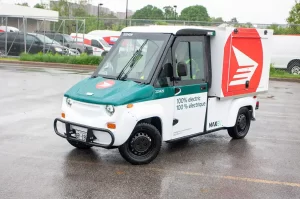Emergency Medical Services (EMS) play a critical role in public health and safety, responding to urgent medical needs with precision and speed. However, one aspect that is often overlooked by industry experts is the increasing integration of specialized utility vehicles into EMS operations. These vehicles, particularly electric models, offer unique advantages such as enhanced maneuverability in congested areas, reduced operational noise, and zero tailpipe emissions, which can significantly improve patient outcomes and environmental impact. This article delves into these often underappreciated benefits and explores how Westward Vehicles is at the forefront of this transformation with their MAX-EV EMS electric vehicle.
Understanding Emergency Medical Services
Emergency Medical Services (EMS) encompass a wide range of activities and responsibilities that are crucial for public health and safety. Despite the well-known functions of EMS, there are several unique aspects that are often underrepresented in industry discussions.
The Scope of EMS Operations
- Diverse Response Scenarios: EMS operations are not limited to urban settings. They extend to rural and remote areas where access to healthcare is limited. Electric utility vehicles, like the MAX-EV EMS, provide the necessary versatility to navigate diverse terrains and ensure timely medical intervention.
- Specialized Medical Equipment: Modern EMS vehicles are equipped with advanced medical technology that can perform initial diagnostics and treatments on-site. This reduces the time to hospital and improves patient survival rates. Electric utility vehicles are particularly suited for carrying sensitive medical equipment due to their smooth, vibration-free operation.
Challenges Faced by EMS Providers
- Accessibility in Congested Areas: Traditional ambulances often face challenges navigating through congested urban areas or during large public events. Electric utility vehicles, with their compact size and enhanced maneuverability, can access locations that are otherwise difficult for larger vehicles. This results in quicker response times and better patient outcomes.
- Environmental Impact: The environmental footprint of EMS operations is rarely discussed. Traditional fuel-powered vehicles contribute to pollution, which can be particularly problematic in densely populated areas. Electric utility vehicles, powered by lithium-ion batteries, offer a sustainable alternative with zero tailpipe emissions, aligning EMS operations with broader environmental goals.
- Operational Costs: The cost of maintaining a fleet of EMS vehicles is significant. Electric utility vehicles present a cost-effective solution with lower maintenance requirements and operational costs. The longevity and reliability of lithium-ion batteries further enhance their economic viability.
Future Directions for EMS
- Integration with Smart City Infrastructure: As cities become smarter, there is an increasing potential for integrating EMS operations with city-wide data networks. Electric utility vehicles equipped with IoT (Internet of Things) technology can provide real-time data to EMS control centers, improving coordination and response times.
- Community-based EMS Programs: Electric utility vehicles can play a pivotal role in community-based EMS programs. Their versatility and ease of use make them ideal for outreach programs, health education, and preventive care in underserved communities.
Westward Vehicles recognizes these unique challenges and opportunities in EMS. Our MAX-EV EMS electric utility vehicle is designed to address these specific needs, offering innovative solutions that enhance the effectiveness and sustainability of emergency medical services.

The Evolution of Utility Vehicles in EMS
The evolution of utility vehicles in Emergency Medical Services (EMS) has seen significant advancements, yet there are several aspects that remain underappreciated in industry discussions. The shift from traditional fuel-powered models to electric utility vehicles represents a pivotal change with profound implications for EMS operations.
Traditional vs. Modern Utility Vehicles
- Emissions and Environmental Impact: Traditional EMS vehicles, powered by internal combustion engines, contribute significantly to urban air pollution. While many discussions focus on general emissions, it is crucial to highlight that electric utility vehicles produce zero tailpipe emissions. This reduction in localized pollution is especially beneficial in urban areas where EMS vehicles often operate.
- Noise Pollution: Another often overlooked benefit of electric utility vehicles is their minimal noise output. Traditional ambulances can be extremely noisy, which adds to the stress of patients and responders. Electric vehicles operate almost silently, reducing noise pollution and creating a calmer environment for medical interventions.
- Heat Reduction: Conventional vehicles generate considerable heat, which can be problematic in crowded or sensitive areas. Electric utility vehicles, due to their efficient energy use, produce significantly less heat. This characteristic is particularly advantageous in disaster scenarios where multiple vehicles may be operating in close proximity.
Technological Advancements
- Energy Efficiency: The efficiency of electric utility vehicles goes beyond just fuel savings. The integration of regenerative braking systems allows these vehicles to recover energy that would otherwise be lost, extending their range and operational time without the need for frequent recharges.
- Advanced Battery Management Systems (BMS): The reliability of lithium-ion batteries is enhanced by sophisticated BMS, which ensures optimal battery performance and longevity. These systems monitor and regulate battery conditions in real-time, preventing failures and ensuring that EMS vehicles are always ready for deployment.
- Telematics and IoT Integration: Modern electric utility vehicles are equipped with telematics systems that provide real-time data on vehicle health, location, and performance. This data can be integrated with EMS command centers, allowing for better fleet management, predictive maintenance, and improved response coordination.
Key Features of the MAX-EV EMS Electric Utility Vehicle
Westward Vehicles has designed the MAX-EV EMS with several unique features tailored specifically for emergency medical services:
- Compact and Maneuverable: The MAX-EV EMS is designed to navigate through tight spaces, making it ideal for urban environments and large public events where accessibility is critical.
- Customizable Medical Modules: The vehicle can be equipped with various medical modules, including advanced life support systems, defibrillators, and oxygen supply units. These modules are designed to be easily accessible and quickly deployable in emergencies.
- Sustainable Operations: With zero tailpipe emissions and energy-efficient operation, the MAX-EV EMS aligns with sustainability goals. This is increasingly important for cities and institutions looking to reduce their carbon footprint and promote green initiatives.
- Rapid Deployment: The MAX-EV EMS can be rapidly deployed due to its quick charging capabilities and reliable lithium-ion batteries. This ensures that the vehicle is always ready to respond to emergencies without extended downtime.
The evolution of utility vehicles in EMS reflects a broader trend towards sustainability, efficiency, and advanced technology. Westward Vehicles is at the forefront of this transformation, offering solutions that address both the practical and environmental needs of modern emergency medical services.
Utility During Medical Emergencies
Utility vehicles play a pivotal role during medical emergencies, and their contribution often extends beyond what is commonly discussed. Electric utility vehicles, such as the MAX-EV EMS from Westward Vehicles, offer unique advantages that enhance the effectiveness of emergency medical services in several often-overlooked ways.
Rapid Response and Patient Transport
- Enhanced Maneuverability: One of the critical advantages of electric utility vehicles is their ability to navigate through congested urban areas and tight spaces where traditional ambulances might struggle. This increased maneuverability ensures that EMS teams can reach patients more quickly, especially in scenarios where every second counts.
- Swift Patient Transfer: Electric utility vehicles can be designed with low-floor entries and wide doors, making it easier and faster to transfer patients in and out of the vehicle. This design minimizes delays and reduces the physical strain on EMS personnel, thereby improving overall response times.
Support in Disaster Scenarios
- Reliable Performance in Adverse Conditions: During natural disasters, access to fuel can be a significant challenge. Electric utility vehicles, equipped with reliable lithium-ion batteries, can operate independently of fuel availability. Their ability to be recharged using portable solar panels or emergency power sources ensures continuous operation even in the most challenging conditions.
- Operational Quietness: In disaster scenarios, the quiet operation of electric vehicles can be crucial. The low noise levels not only reduce stress for patients and responders but also make it easier to communicate and coordinate efforts in chaotic environments. This is a critical, yet often overlooked, advantage that enhances operational efficiency.
Field Medical Support and Logistics
- Mobile Medical Units: Electric utility vehicles can be equipped with advanced medical equipment, turning them into mobile clinics that provide critical care on the spot. This capability is invaluable during large-scale emergencies where traditional medical facilities might be overwhelmed.
- Logistical Support: Beyond patient transport, electric utility vehicles can serve as essential logistical support units. They can be used to transport medical supplies, equipment, and personnel quickly and efficiently across various terrains. This logistical flexibility ensures that EMS teams have the resources they need, wherever they are needed.
Community Outreach and Preventive Care
- Health Education and Outreach: Electric utility vehicles can be used for community outreach programs, providing health education and preventive care services in underserved areas. Their mobility allows them to bring medical services directly to communities that might otherwise have limited access to healthcare.
- Vaccination and Screening Programs: During public health crises, electric utility vehicles can be deployed for mass vaccination and screening programs. Their ability to operate in diverse environments makes them ideal for reaching populations in both urban and rural settings.
Westward Vehicles’ MAX-EV EMS model is designed with these unique advantages in mind, ensuring that emergency medical services are equipped to handle a wide range of scenarios with greater efficiency and sustainability. By integrating advanced features and leveraging the benefits of electric power, these vehicles provide a robust solution for modern EMS challenges.

Advantages of the MAX-EV EMS in EMS
Electric utility vehicles like the MAX-EV EMS from Westward Vehicles bring a myriad of advantages to emergency medical services, many of which are not typically discussed by industry thought leaders. These benefits extend beyond the obvious environmental perks and delve into operational efficiencies and broader impacts on EMS capabilities.
Environmental Impact
- Zero Tailpipe Emissions: Unlike traditional fuel-powered vehicles, the MAX-EV EMS produces zero tailpipe emissions, significantly reducing air pollution. This is particularly beneficial in urban areas where air quality is a major concern. The reduction in pollutants also aligns with public health goals, contributing to a cleaner and healthier environment.
- Reduced Carbon Footprint: The use of electric vehicles in EMS operations supports sustainability initiatives by lowering the overall carbon footprint. By utilizing renewable energy sources for charging, EMS fleets can further decrease their environmental impact, setting a precedent for green practices in public services.
Cost Efficiency
- Lower Operating Costs: Electric utility vehicles have fewer moving parts compared to internal combustion engine vehicles, which translates to lower maintenance costs. The reliability of lithium-ion batteries means fewer breakdowns and less frequent servicing, resulting in cost savings over the vehicle’s lifespan.
- Energy Savings: The cost of electricity is generally lower than gasoline or diesel, leading to substantial savings in fuel costs. Additionally, regenerative braking systems in electric vehicles like the MAX-EV EMS recover energy that would otherwise be lost, further enhancing their cost efficiency.
- Extended Vehicle Life: Electric utility vehicles tend to have a longer operational life due to reduced mechanical wear and tear. This longevity ensures a better return on investment for EMS providers, making it a financially sound choice in the long run.
Operational Efficiency
- Enhanced Maneuverability: The compact design and enhanced maneuverability of the MAX-EV EMS enable faster response times, particularly in congested or hard-to-reach areas. This agility ensures that EMS teams can provide timely medical assistance, improving patient outcomes.
- Versatile Applications: The customizable nature of the MAX-EV EMS allows it to be outfitted with specialized medical equipment. This includes an extended custom deck to securely fasten a full-size gurney, optional 4WD for off-road capabilities, and a towing capacity of up to 1,500 lbs. Whether it’s a rapid response unit or a mobile clinic, the MAX-EV EMS can adapt to meet specific needs.
- Advanced Safety Features: The MAX-EV EMS is equipped with cutting-edge safety features, such as enhanced visibility options and collision avoidance systems. These features improve the safety of both EMS personnel and patients being transported.
- On-Road and Off-Road Versatility: The MAX-EV EMS comes in both LSV (low-speed vehicle) and ORV (off-road vehicle) versions. The ORV variant is particularly valuable for EMS operations in remote or rugged terrains. With optional 4WD, the ORV version can navigate challenging landscapes, ensuring that emergency medical services can reach patients in areas that are otherwise inaccessible to traditional vehicles.
Technological Advancements
- Telematics and Data Integration: The integration of telematics systems in electric utility vehicles provides real-time data on vehicle health, location, and performance. This data can be leveraged to optimize fleet management, ensure predictive maintenance, and enhance operational coordination.
- Battery Management Systems: The advanced battery management systems in the MAX-EV EMS ensure optimal battery performance and longevity. This is critical for maintaining reliable operations during emergency responses.
Community Impact
- Public Perception and Support: The use of electric vehicles in EMS fleets can enhance public perception and support for EMS providers. Demonstrating a commitment to sustainability and innovation resonates well with communities, fostering trust and appreciation.
- Educational Opportunities: The deployment of electric utility vehicles offers opportunities for public education on the benefits of sustainable practices. EMS providers can leverage their use of electric vehicles to promote environmental awareness and encourage community engagement.
Westward Vehicles’ MAX-EV EMS model not only addresses the immediate needs of emergency medical services but also contributes to broader societal goals. By embracing the advantages of electric utility vehicles, EMS providers can enhance their operational effectiveness while supporting environmental and economic sustainability. The MAX-EV EMS is well-suited for both on-road and off-road applications, making it a versatile and indispensable asset for any EMS fleet. The ORV version’s capabilities in challenging terrains expand the reach and efficiency of EMS operations, ensuring no patient is out of reach.
Conclusion
The integration of electric utility vehicles like the MAX-EV EMS into emergency medical services signifies a transformative shift towards more efficient, sustainable, and versatile EMS operations. These vehicles not only offer zero tailpipe emissions, contributing to better urban air quality and reduced carbon footprints, but also enhance operational efficiency with lower maintenance costs and improved maneuverability. The ability to navigate both on-road and off-road environments ensures that EMS teams can respond swiftly and effectively, regardless of the terrain.
Moreover, the technological advancements embedded in the MAX-EV EMS, such as advanced telematics and battery management systems, provide EMS providers with real-time data and enhanced reliability. This results in better fleet management, predictive maintenance, and overall improved patient outcomes. As Westward Vehicles continues to innovate and adapt to the evolving needs of emergency medical services, the MAX-EV EMS stands out as a pioneering solution that addresses both immediate operational needs and broader environmental goals.
